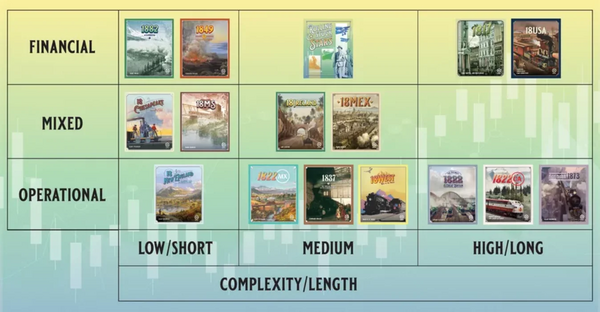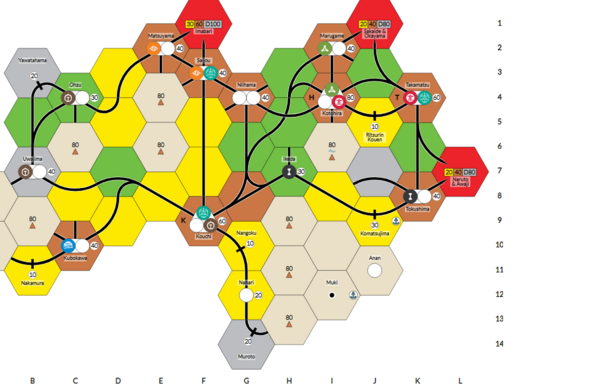18XX Primer
02 Aug 202418xx 101
Here’s a tutorial for 1889 on the 18xx.games platform: 18xx Games Tutorial. It walks you through turns of a three-player game, illustrating typical gameplay elements.
For 18xx games, most are derived from 1830 with modifications (sometimes significant ones that the community refers to as “McGuffins”). Key variations include the maps, available companies, tile availability, and train rules. Additionally, auction methods for companies, stock market mechanisms, and company-specific rules often differ, leading to uniquely challenging games.
Although 1830 is one of the earliest 18xx games, it followed the lesser-known 1829. 1830 is the foundation for most other 18xx games.

The more introductory games like 1889, 18Chesapeake, and 18MS, which are based on financial strategies from 1830. These games focus on timing investments and manipulating stock prices. The most significant game in this financial category is 1817, which can last over 12 hours due to its complex stock market dynamics.
Another category within the 18xx series focuses on operational games, such as 1846, designed by the creator of Race for the Galaxy. 1846 emphasizes efficient company operation, route competition, and critical timing of train upgrades, making it an accessible entry point for those new to operational strategies within the 18xx series. 1822, another significant game in this genre, is known for its lengthy gameplay and intricate management of private companies, but it may not be as suited for beginners due to its complexity.
Gameplay typically alternates between Stock Rounds and Operating Rounds, which may vary in number as the game progresses. During Stock Rounds, players buy and sell shares, affecting company valuations. In Operating Rounds, companies operate trains, manage routes, handle dividends, and invest in new trains. A crucial tip for beginners is to prioritize train purchases, which can accelerate game progression and disrupt opponents’ strategies.
Trains, which have finite lifespans, need careful management to prevent obsolescence and ensure operational efficiency. Newer trains make older models obsolete (“rusting”), forcing players to continually adapt their strategies. Companies are usually divided into public and private. Private companies, often starting smaller, can later be integrated into public ones, providing strategic financial benefits. Company funds stem solely from share purchases, and operational decisions during rounds can significantly impact overall success.
Tracks are categorized into three types: Yellow, Green, and Brown, representing different stages of development. Starting with Yellow, players can upgrade to Green and then Brown, each providing different strategic options. Tile availability is typically limited, encouraging strategic placement to potentially hinder opponents’ expansion.
During Operating Rounds, per train you can run a route where track cannot be reused by your company for multiple routes. You can’t backtrack normally. The number of stations a train visits, typically its numeric value like a “2 train” or a “4 train,” is crucial as it dictates the potential revenue from that route. Each station adds a set value to the route’s total income, influencing strategic decisions about train operations and route planning.
Here is an example board from a completed 1889 game:

Example: If you had a station in Nahari, and two “2” trains, you could run two routes. One from Muroto to Nahari for 40 dollars, and one from Nangoku to Nanari for 30. A total of 70 for the operating round.
If you had a 3 train, you could run between Muroto to Nanori to Nangoku for 50, or if you additionally had a station in Kouchi and a 3 train, you could run to Kouichi to Nangoku to Nanari for 90.
You may not reuse track during a route, but you may visit a station with multiple trains as long as you do not resuse track.